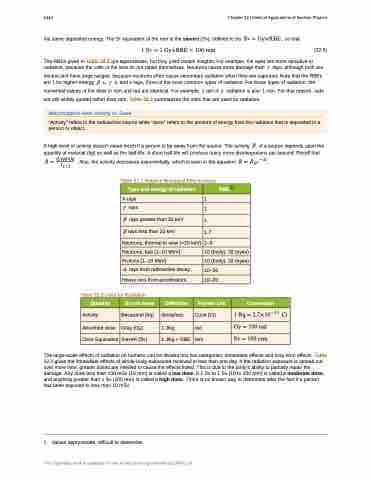Page 1456 - College Physics For AP Courses
P. 1456
1444 Chapter 32 | Medical Applications of Nuclear Physics
the same deposited energy. The SI equivalent of the rem is the sievert (Sv), defined to be �� � ������ , so that
� �� � � ������ � ��� ���� (32.6)
The RBEs given in Table 32.2 are approximate, but they yield certain insights. For example, the eyes are more sensitive to radiation, because the cells of the lens do not repair themselves. Neutrons cause more damage than � rays, although both are
neutral and have large ranges, because neutrons often cause secondary radiation when they are captured. Note that the RBEs are 1 for higher-energy � s, � s, and x-rays, three of the most common types of radiation. For those types of radiation, the
numerical values of the dose in rem and rad are identical. For example, 1 rad of � radiation is also 1 rem. For that reason, rads are still widely quoted rather than rem. Table 32.3 summarizes the units that are used for radiation.
A high level of activity doesn't mean much if a person is far away from the source. The activity � of a source depends upon the quantity of material (kg) as well as the half-life. A short half-life will produce many more disintegrations per second. Recall that
� � ������ . Also, the activity decreases exponentially, which is seen in the equation � � � ���� . ���� �
Table 32.2 Relative Biological Effectiveness
Misconception Alert: Activity vs. Dose
“Activity” refers to the radioactive source while “dose” refers to the amount of energy from the radiation that is deposited in a person or object.
Type and energy of radiation RBE[1]
X-rays 1
� rays
1
� rays greater than 32 keV
1
� rays less than 32 keV
1.7
Neutrons, thermal to slow (<20 keV) 2–5
Neutrons, fast (1–10 MeV) 10 (body), 32 (eyes)
Protons (1–10 MeV) 10 (body), 32 (eyes)
� rays from radioactive decay 10–20
Heavy ions from accelerators 10–20
Table 32.3 Units for Radiation
The large-scale effects of radiation on humans can be divided into two categories: immediate effects and long-term effects. Table 32.4 gives the immediate effects of whole-body exposures received in less than one day. If the radiation exposure is spread out over more time, greater doses are needed to cause the effects listed. This is due to the body's ability to partially repair the damage. Any dose less than 100 mSv (10 rem) is called a low dose, 0.1 Sv to 1 Sv (10 to 100 rem) is called a moderate dose, and anything greater than 1 Sv (100 rem) is called a high dose. There is no known way to determine after the fact if a person has been exposed to less than 10 mSv.
1. Values approximate, difficult to determine.
Quantity SI unit name Definition Former unit Conversion
Activity Becquerel (bq) decay/sec Curie (Ci) � �� � ��������� ��
Absorbed dose Gray (Gy) 1 J/kg rad
�� � ��� ���
Dose Equivalent Sievert (Sv) 1 J/kg × RBE rem �� � ��� ���
This OpenStax book is available for free at http://cnx.org/content/col11844/1.14


